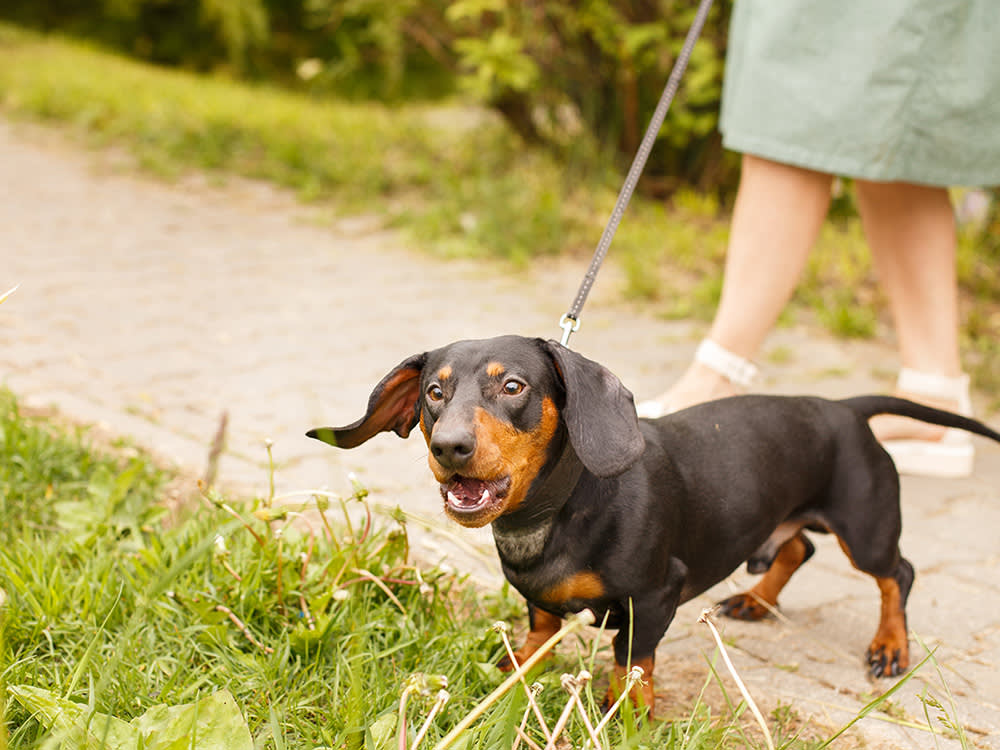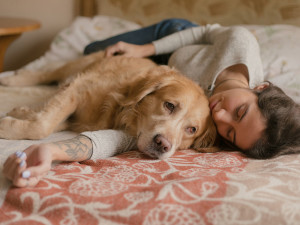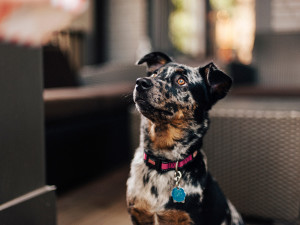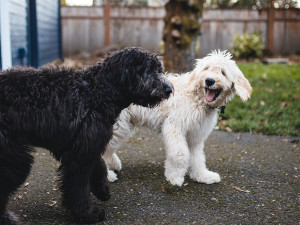Is Your Out-of-Control Dog Lunging on the Leash?
Even a mild-mannered dog can turn into a wild thing when feeling trapped.

Share Article
It begins with your dog’s body becoming tense, their ears stand up, and they are staring straight ahead at their worst fear. Coming your direction is a hound roughly four times their size that is clearly eager to investigate your pup, and their person appears just as eager to allow them to.
Sure, their dog is friendly, but the problem in this scenario is that your dog — and many other leash reactive dogs like them — has no, zilch, notta single interest in meeting the hound.
Leash reactivity is when a dog is barking, lunging, and/or growling while on leash in response to the presence of a particular stimulus. When exposed to something that frightens them, such as another dog, these dogs will do their best to send the message that they aren’t ok. You might see a dog pulling on their leash as forcefully as possible and barking ferociously. Putting their behavior into words, I imagine them saying, “Uh-uh! You need to stay away from me! Keep your distance! I said, get the hell away!”
Often this type of behavior is embarrassing for the pet parents on the other end of the leash. You might even find yourself apologizing for the behavior. However, as a dog trainer with an education in dog behavior and because of years of experience working with dogs, I don’t blame the dog for their behavior one little bit.

Figuring out why your dog lunges at other dogs.
In one training session, my client Rocket, a scrappy terrier mix, no more than 15 pounds, did his very best to prevent a situation that made him feel powerless, uncertain and downright fearful. Yet, Rocket’s worst fears were brought to life as he was on a leash, trapped and unable to stop a much larger dog from doing exactly as he pleased. And unfortunately, Rocket’s pet parent wasn’t having it. She was embarrassed and frustrated.
But I explained to her that dogs like Rocket don’t seek opportunities to embarrass their pet parents. He is using the language he speaks to communicate to other dogs that he does not want to mingle. Again, this could be because he doesn’t like the sensation of being trapped. He may be motivated by an event in his past, perhaps involving a fight. He may simply prefer to have space between him and other dogs. (I’m sure many of us can relate — do you love inspecting your co-worker’s facial pores as he invades your personal space every time you interact?) What Rocket’s behavior should communicate to other dogs is not always respected by other dogs, or other humans, for that matter.
How to respond to a dog lunging or barking on leash.
So, what is my approach? How do I help the Rockets of this world learn to deal with things that scare them? I decipher their loudly shouted messages, share them with their people, and build each dog’s trust in their people. I create a bridge of communication between human and dog. All of these approaches allow the Rockets to relax a little more with every walk and, consequently, allow their people to relax, too. No need for embarrassment or overwhelming fear. Let’s break down this approach.
1. Read your dog’s body language.
How do you get the messages your dog is sharing? You need to better understand their body language and their “spoken” language, as well. This can be tough, but many great resources on canine language exist; here’s a good place to start. I’m partial, both from a scientific and ethical perspective to positive reinforcement.
2. Earn your dog’s trust.
How do you build trust between you and your dog? It starts by learning to recognize what your dog is saying, which makes it easier to respond appropriately. Once you identify their fear and your dog’s inability to handle close proximity to another dog or human, it allows you to understand that putting distance between a dog and their feared stimuli provides reassurance. Visual barriers can also calm or soothe a fearful dog.
3. Communicate through training.
Next, and my favorite, how do you build a bridge of communication with a member of another species? One option is to create a shared language; to do this, you train. My training cue of choice for lunging dogs is a form of focus called “look” or “watch.” With proper education and lots of practice, you can ask for attention from your dog as the two of you enter a questionable situation. Asking for focus helps prevent further reactions from the dog. If, thanks to shared communication and distraction techniques, the situation never becomes too frightening, there is no need for the Rocket of this scenario to lunge or send a loud, barking message.
It gets better.
Here’s the best part: at some point, you may not even need to ask for your dog’s focus. With practice, your dog may choose to handle the situation themself by looking at you (rather than lunge or bark) when they encounter a worrisome situation. Let me tell you, this is an exhilarating moment the first time it happens. Even though I’ve seen it hundreds of times, I still want to leap into the air with excitement.
As pet parents who have chosen to bring another species into your daily lives, you have an obligation to try to understand what your dogs are telling you. Likewise, you have an obligation to try to improve your relationship using this acquired knowledge.
There’s no need to feel embarrassed. Have a “chat” with your dog, and rediscover that walks with your best friend really are one of the best parts of your day.

Maggie Lange
Maggie Lange is a writer, editor, and columnist. Her work has been featured in New York Magazine, Vice, Guernica, GQ, Rolling Stone, Pitchfork, Elle, and Bon Appetit. She lives in Philadelphia with her favorite brindle boy, Finn.
Related articles
How to Manage Leash Reactivity in Your Dog
If your pup acts diabolical on walks, you are not alone. Here’s what you can do.
Does Your Dog Need Anti-Anxiety Meds?
How to cope with dog anxiety—from training to medication.
Do Dogs Understand Our Words?
Say What? A look at the types of words that dogs understand.
![Two dogs playfully standing next to each other outside.]()
“Why Don’t My Dogs Get Along Anymore?”
Why relationships change in multi-dog households.





